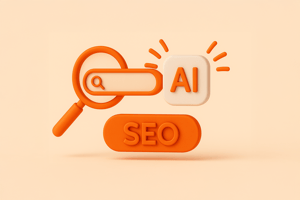
SEO: AI Changes the Game, but Not the Rules
While Google processes around 13 billion search queries per day worldwide, ChatGPT now reaches over 1 billion daily requests. A development that shows: traditional search engines remain dominant, but AI-powered systems are catching up rapidly and changing the way people find information.
1. SEO: A Stable Foundation
SEO has long been the tool for digital visibility. Successful ranking is based on proven elements: well-structured content, precise title tags, compelling meta descriptions, clear heading hierarchies, internal linking, fast loading times, mobile-optimized pages, and structured data. The technology behind it ensures that search engine crawlers can efficiently capture and index content. Added to this is the building of high-quality backlinks and continuously relevant content.
As mentioned in the first article of this series, classic SEO was primarily about making it as easy as possible for search engine crawlers to access relevant, well-structured information. Those who understood and applied these rules could plan and build rankings sustainably.
But the rules of the game are changing.
2. What’s Changing: The Role of AI Systems in Search
More and more users are asking their questions directly to AI systems such as ChatGPT or Perplexity. Voice assistants and new interfaces like the Search Generative Experience (SGE) are also shifting attention away from traditional search results. The consequence: content must now be optimized not only for search engine crawlers but also for AI-based answer systems.
At the same time, the question arises whether this represents a real paradigm shift or just a hype that creates uncertainty but changes little in the fundamentals. Is AI-SEO truly essential or merely an evolution of existing strategies? Is there urgent need for action, or is it enough to observe developments with a clear head and respond selectively?
Marketers should understand this distinction. Because between strategic evolution and unnecessary panic lies a difference that determines efficiency and relevance.
3. New Technical Requirements: GPTBot, SGE Crawlers and More
With the Search Generative Experience (SGE), Google is introducing a new search concept. The classic list of results is supplemented by an AI-generated answer displayed directly above the organic listings. ChatGPT, Perplexity, and other systems also actively access web content. For this, they use specialized crawlers such as GPTBot.
Unlike traditional search engines, these systems do not just capture content for indexing, but analyze it to generate independent answers. While Google SGE still works closely with the existing search index, Gemini is Google’s standalone AI chat, where answers are generated independently of the traditional search process. This results in new requirements for the technical preparation of content.
What AI Crawlers Expect Today
Semantic HTML structure
A clean structure with elements such as article, section, header, h1–h3 or ul makes it easier for AI crawlers to interpret content correctly. Tables or structured lists also support understanding.
Structured data with Schema.org
By integrating markup for FAQPage, HowTo, Article, or WebPage, content becomes easier to read for AI systems. This markup makes it possible for content to be selected as a direct answer source.
Ensure machine readability
Content should not be loaded exclusively via JavaScript. Server-side rendering or HTML fallbacks ensure that content can be fully captured.
Focused text blocks with high density
AI systems analyze content section by section. Clearly written paragraphs that focus precisely on one question or topic have a higher chance of being selected.
Performance and usability
Loading speed, mobile optimization, and technical setup remain important. AI systems also prefer content that is fast to access and user-friendly.
4. From Optimization to Strategic Realignment
Instead of being optimized solely for indexing by traditional search crawlers, content today must be structured so that AI systems can directly understand and process it as answers. This is exactly where Answer Engine Optimization (AEO) comes in. The goal is to provide content that is not only discoverable but also specifically used as an answer source.
The requirements are rising. Clear structure, semantic depth, and technical markup are crucial to remain visible in the new ecosystem of AI-based search. Visibility no longer simply means ranking positions. It requires presence at the decisive moment when users expect a concrete answer.
What this means in practice will be covered in detail in the upcoming articles of this series. These will focus on LEO (Language Engine Optimization), GEO (Generative Engine Optimization), and AEO (Answer Engine Optimization). Each part will show, using concrete examples, how to structure, optimize, and technically prepare content to achieve visibility in ChatGPT, Google SGE, Perplexity, and other AI systems.
This series provides a step-by-step foundation for a modern visibility strategy—far beyond classic SEO.
FAQ
AI crawlers do not just analyze content for indexing but for direct answer generation. They evaluate semantic structure, clarity, and context. Technical cleanliness, structured data, and machine-readable content are essential for them to accurately capture information and use it as an answer source.
.jpg?width=290&name=portrait_square%20(1).jpg)